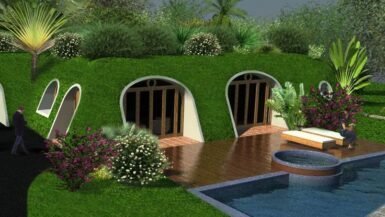In recent years, the tiny home movement has gained significant traction as an alternative housing option for those seeking a more sustainable and minimalist lifestyle. In this article, we will discuss the profound impact that tiny homes can have on local ecosystems. We will delve into the various ecological benefits of adopting a tiny home lifestyle, such as reduced resource consumption, minimal land disturbance, and the promotion of energy-efficient technologies. Additionally, we will examine potential challenges and considerations for integrating these small dwellings into the natural environment without causing undue harm. Join us as we explore the intersection of sustainable living and environmental stewardship through the lens of tiny homes and their influence on local ecosystems.
Reducing Environmental Footprint with Tiny Home Designs
As the world grapples with climate change and dwindling natural resources, the need for sustainable housing solutions has become increasingly urgent. Tiny homes offer an innovative, eco-friendly approach to residential design that can significantly reduce the environmental impact of our living spaces. In this section, we will explore various tiny home design elements that contribute to a smaller ecological footprint, focusing on aspects such as size, materials, and layout.
Maximizing Space Efficiency with Compact Design
One of the primary ways that tiny homes contribute to a reduced environmental footprint is through their inherently compact design. Smaller living spaces require fewer raw materials for construction and generate less waste during the building process. Additionally, tiny homes are often designed with multifunctional spaces and built-in storage solutions, which can help to minimize the need for excess furniture and household items, further reducing resource consumption.
Utilizing Sustainable Building Materials
The choice of building materials can greatly impact the ecological footprint of a tiny home. Many tiny home builders prioritize the use of sustainable, eco-friendly materials, such as reclaimed wood, recycled metals, and natural insulation options like sheep’s wool or cellulose. By incorporating these environmentally responsible materials, tiny homes can significantly reduce their carbon footprint and contribute to a healthier local ecosystem.
Smart Energy and Water Management Systems
The integration of smart technology and renewable energy sources can greatly enhance the sustainability of tiny homes. Solar panels, energy-efficient appliances, and LED lighting are just a few examples of how tiny home owners can minimize their reliance on nonrenewable energy sources. Additionally, water-saving fixtures and rainwater harvesting systems can help to reduce water consumption and alleviate the strain on local water supplies.
Biophilic Design Elements for Enhanced Well-being
Integrating natural elements into tiny home design can not only improve the aesthetics of the space, but also contribute to the well-being of both residents and the surrounding ecosystem. Biophilic design, which seeks to connect occupants with nature, can be achieved by incorporating features such as living walls, indoor gardens, and extensive use of natural light. These design elements can help to purify indoor air, support local biodiversity, and promote overall environmental health.
As we have seen, the thoughtful design and construction of tiny homes can greatly contribute to a reduced environmental footprint. By embracing compact living spaces, sustainable building materials, and eco-friendly technologies, tiny home owners can foster a more harmonious relationship with the natural world and minimize their impact on local ecosystems.
Eco-Friendly Materials and Techniques for Tiny House Construction
When building a tiny home, the selection of materials and construction techniques can have a significant impact on the overall sustainability and ecological footprint of the dwelling. In this section, we will delve into various eco-friendly materials and techniques that can be employed in the construction of tiny homes, contributing to a healthier and more sustainable living environment while minimizing the impact on local ecosystems.
Reclaimed and Recycled Building Materials
Utilizing reclaimed and recycled materials is an excellent way to reduce the environmental impact of tiny home construction. By repurposing materials such as reclaimed wood, recycled metal, and even salvaged shipping containers, builders can conserve valuable resources, divert waste from landfills, and reduce the energy consumption associated with the production of new materials. Additionally, these materials often come with unique character and charm, adding a touch of history and personality to the tiny home.
Natural and Sustainable Insulation Options
The choice of insulation can greatly influence the energy efficiency and ecological footprint of a tiny home. Natural insulation materials like sheep’s wool, cellulose, and cork offer excellent thermal performance while being environmentally friendly and renewable. These materials also tend to have lower embodied energy, meaning that they require less energy to produce and transport compared to their synthetic counterparts.
Low-Impact Construction Techniques
Adopting low-impact construction techniques can minimize the disturbance to the surrounding environment during the tiny home building process. Techniques such as pier foundations, which elevate the home off the ground, can help preserve the natural soil structure and protect delicate root systems. Additionally, using manual tools and local labor can reduce the carbon footprint associated with heavy machinery and long-distance transportation of materials.
Green Roofs and Living Walls
Incorporating green roofs and living walls not only enhances the aesthetic appeal of tiny homes but also provides numerous ecological benefits. Green roofs can improve air quality, support local biodiversity, and help to regulate indoor temperatures, reducing the need for energy-intensive heating and cooling systems. Living walls, on the other hand, can serve as natural air filters and sound barriers while adding a touch of nature to the home’s interior.
Passive Solar Design Principles
Implementing passive solar design principles can greatly improve the energy efficiency and comfort of a tiny home. By strategically positioning windows, thermal mass, and shading devices, tiny home builders can harness the power of the sun to provide natural lighting, heating, and cooling, reducing reliance on nonrenewable energy sources and minimizing the impact on local ecosystems.
As demonstrated, employing eco-friendly materials and techniques in the construction of tiny homes can substantially reduce their environmental footprint and contribute to the preservation and health of local ecosystems. By embracing these sustainable practices, tiny home builders and residents can achieve an environmentally responsible and harmonious living environment that respects and protects the natural world.
Enhancing Biodiversity through Tiny Home Landscaping
The impact of tiny homes on local ecosystems extends beyond their efficient design and sustainable construction methods. Thoughtful landscaping around these small dwellings can contribute to the preservation and enhancement of biodiversity, fostering a symbiotic relationship between tiny home residents and the surrounding environment. In this section, we will explore various landscaping approaches that can be implemented to support local flora and fauna while enriching the aesthetic appeal and ecological value of tiny home living spaces.
Native Plant Landscaping
Incorporating native plant species into tiny home landscaping can provide numerous ecological benefits. Native plants are naturally adapted to local climate conditions and soil types, requiring less water and maintenance compared to exotic species. Additionally, they provide essential habitat and food sources for local wildlife, supporting pollinators, birds, and other beneficial creatures.
Pollinator Gardens
Creating a pollinator garden around a tiny home can significantly enhance local biodiversity by providing crucial resources for bees, butterflies, and other pollinating insects. Selecting a variety of flowering plants that bloom throughout the year will ensure a consistent food supply for pollinators, while also contributing to the aesthetic appeal of the landscaping. Incorporating nesting sites, such as bee hotels or butterfly houses, can further support these essential species and foster a healthy ecosystem.
Permaculture Principles
Applying permaculture principles to tiny home landscaping can create a self-sustaining, ecologically harmonious environment that benefits both residents and the surrounding ecosystem. Permaculture emphasizes the use of natural systems and processes to create resilient, productive landscapes with minimal external inputs. By designing edible gardens, rainwater harvesting systems, and wildlife habitats, tiny home owners can create a thriving ecosystem that supports biodiversity and promotes sustainable living.
Stormwater Management
Effective stormwater management is crucial for protecting local waterways and ecosystems from pollution and erosion. Tiny home landscapes can be designed to capture, filter, and infiltrate stormwater runoff, reducing the impact on nearby bodies of water. Techniques such as rain gardens, bioswales, and permeable paving can help to minimize water pollution, recharge groundwater supplies, and support the overall health of the local ecosystem.
Wildlife Corridors
Integrating wildlife corridors into tiny home landscaping can provide essential connectivity between fragmented habitats, allowing animals to move freely and access vital resources. Planting hedgerows, native shrubs, and trees can create natural pathways for wildlife, while also offering privacy and aesthetic appeal for tiny home residents. Incorporating features such as bird baths, feeders, and nesting boxes can further support local wildlife populations and contribute to a thriving ecosystem.
In summary, the positive impact of tiny homes on local ecosystems can be significantly enhanced through mindful landscaping practices that prioritize biodiversity and ecological health. By incorporating native plants, pollinator gardens, permaculture principles, stormwater management techniques, and wildlife corridors, tiny home owners can create thriving outdoor spaces that support local flora and fauna while enriching their own living experience.
Energy and Water Conservation Strategies in Tiny Living
The impact of tiny homes on local ecosystems can be further enhanced by adopting various energy and water conservation strategies. In this section, we will discuss several approaches that can be implemented to improve the efficiency of energy and water usage in tiny homes, contributing to a more sustainable lifestyle and reducing the strain on local resources.
Harnessing Renewable Energy Sources
One of the key strategies for conserving energy in tiny living is to harness renewable energy sources, such as solar and wind power. Installing solar panels on rooftops or employing portable solar generators can significantly reduce dependence on nonrenewable energy sources and minimize the carbon footprint of tiny homes. Additionally, small-scale wind turbines can be a viable option in areas with consistent wind patterns, further contributing to a clean and sustainable energy supply.
Implementing Energy-Efficient Appliances and Lighting
Equipping tiny homes with energy-efficient appliances and lighting can greatly reduce overall energy consumption. Choosing appliances with the ENERGY STAR® label ensures that they meet strict energy efficiency guidelines set by the Environmental Protection Agency. Similarly, opting for LED lighting can significantly lower energy usage compared to traditional incandescent bulbs, while also providing a longer lifespan and improved performance.
Optimizing Insulation and Ventilation
Proper insulation and ventilation are crucial for maintaining a comfortable indoor environment while minimizing energy usage for heating and cooling. Ensuring that tiny homes are well-insulated and air-sealed can prevent heat loss in colder months and heat gain in warmer months, reducing the need for energy-intensive climate control systems. Installing energy-efficient windows and strategically placed vents can also contribute to improved indoor air quality and temperature regulation.
Water-Saving Fixtures and Appliances
Conserving water is an essential aspect of sustainable tiny living, as it helps to alleviate pressure on local water supplies and reduce the energy required for water treatment and distribution. Incorporating water-saving fixtures, such as low-flow faucets, showerheads, and dual-flush toilets, can significantly cut down on water consumption without sacrificing comfort or functionality. Energy-efficient dishwashers and washing machines can also contribute to water conservation while reducing energy usage.
Adopting Water Harvesting and Reuse Techniques
Collecting and reusing water can further contribute to the conservation of this precious resource in tiny homes. Rainwater harvesting systems can capture and store rainwater for use in landscaping, gardening, or even for flushing toilets. Additionally, greywater recycling systems can treat and reuse water from sinks, showers, and washing machines for irrigation or other non-potable purposes. These innovative techniques not only conserve water but also help reduce the burden on local wastewater treatment facilities.
Embracing various energy and water conservation strategies in tiny living can significantly reduce the ecological footprint of these dwellings and promote a more sustainable lifestyle. From harnessing renewable energy sources and implementing energy-efficient appliances to adopting water-saving fixtures and innovative water reuse techniques, tiny home residents can contribute positively to the health and preservation of local ecosystems while enjoying comfortable and resource-efficient living spaces.
Tiny Homes and Sustainable Waste Management Solutions
In addition to their efficient design, sustainable construction, and eco-friendly landscaping practices, tiny homes can also contribute positively to local ecosystems through the implementation of sustainable waste management solutions. In this section, we will explore various approaches to managing waste in tiny homes, focusing on strategies that can minimize environmental impact while promoting a more circular and resource-conscious lifestyle.
Composting Toilets for Sustainable Human Waste Management
One innovative solution for sustainable waste management in tiny homes is the use of composting toilets. These systems separate solid waste from liquid waste, allowing for the natural decomposition of solids into nutrient-rich compost. By transforming human waste into a valuable resource, composting toilets can reduce the burden on local wastewater treatment facilities, conserve water, and contribute to a healthier and more sustainable ecosystem.
Waste Reduction through Minimalism and Mindful Consumption
The minimalist lifestyle often associated with tiny living can contribute to a significant reduction in household waste. By consciously choosing to own fewer possessions and prioritizing quality over quantity, tiny home residents can minimize the amount of waste generated through the consumption and disposal of material goods. Adopting a mindful approach to consumption not only reduces waste but also conserves valuable resources and promotes a more sustainable and eco-friendly way of life.
Recycling and Proper Waste Segregation
Effective waste management in tiny homes also involves the proper segregation and recycling of waste materials. By separating recyclable materials such as paper, glass, metals, and plastics, tiny home residents can ensure that these resources are diverted from landfills and reintroduced into the manufacturing process. Additionally, proper waste segregation can help prevent contamination of recyclable materials, ensuring that they maintain their value and can be effectively repurposed.
Organic Waste Management through Composting and Vermicomposting
Organic waste, such as food scraps and yard trimmings, can be effectively managed through composting and vermicomposting techniques. Composting involves the aerobic decomposition of organic materials into nutrient-rich humus, which can be used to enrich garden soils and support plant growth. Vermicomposting, on the other hand, utilizes worms to break down organic waste, producing a highly fertile byproduct known as worm castings. Both methods can help tiny home residents reduce their waste output, support local ecosystems, and contribute to the overall health of the environment.
Community-Based Waste Management Initiatives
Tiny home residents can also participate in community-based waste management initiatives, such as sharing tools and equipment, collaborating on waste reduction projects, or engaging in neighborhood clean-ups. By working together with neighbors and local organizations, tiny home communities can collectively address waste management challenges and contribute to a cleaner, healthier, and more sustainable ecosystem.
In summary, the adoption of sustainable waste management solutions in tiny homes can further enhance their positive impact on local ecosystems. By implementing composting toilets, reducing waste through minimalism, recycling and segregating waste, managing organic waste, and participating in community-based initiatives, tiny home residents can contribute to the preservation and health of the environment while enjoying a resource-efficient and eco-conscious lifestyle.





Leave a reply